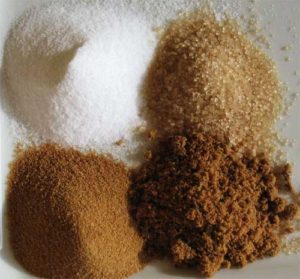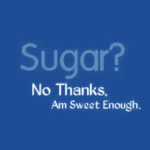I’ve got sugar on my mind. It’s not because I have a “sweet tooth” (although I certainly do have one). It’s because I’m startled by all the things I’m learning about its effect on our bodies.
You might recall an earlier post where I reported that sugar stimulates the pleasure centers of our brains in ways that mirror addictive drugs. The drive for reward overpowers our internal control mechanisms. Chronic exposure to highly palatable foods rewires our brains and compels us to seek its rewards. I also learned that sugar is the dietary factor most closely associated with coronary heart disease, courtesy of Dr. Jonny Bowden, PhD and Dr. Stephen Sinatra, MD.
So I’ve done a little deeper dive on sugar via the Internet and a quick read of nutrition and fitness expert JJ Virgin’s book, Sugar Impact Diet. Here’s what I’ve learned:
 The average American eats 22 teaspoons of sugar a day. It comes straight out the sugar bowl and is hidden in a lot of the foods we eat. It shows up in sweet drinks (sodas, teas), sauces, dressings, condiments, packaged fruit, and even diet foods. Reduced fat foods often use sweeteners to create a compelling offering. “No Added Sugar” may simply mean that the product was sweetened with fruit juice concentrate. And, of course, highly processed carbohydrates turn to sugar rapidly in the bloodstream.
The average American eats 22 teaspoons of sugar a day. It comes straight out the sugar bowl and is hidden in a lot of the foods we eat. It shows up in sweet drinks (sodas, teas), sauces, dressings, condiments, packaged fruit, and even diet foods. Reduced fat foods often use sweeteners to create a compelling offering. “No Added Sugar” may simply mean that the product was sweetened with fruit juice concentrate. And, of course, highly processed carbohydrates turn to sugar rapidly in the bloodstream.
Our bodies weren’t engineered to process an onslaught of sugar, whether delivered in sugary desserts or copious amounts of refined starches (breads, pastas). If we flood our bloodstream with sugar, we wind up having to dose ourselves with large amounts of insulin to process it all. Excess insulin can cause a precipitous drop in blood sugar that will make us feel irritable, foggy, and listless… until we get our next sugar fix and the cycle repeats.
Sugar can mess with other hormones, too. Ghrelin (the “hunger hormone”) sends our brain the signal to eat when the stomach is empty or the blood sugar is low. Leptin (the “satiety hormone”) suppresses ghrelin after a meal, thereby letting the brain know that the body has eaten enough. High levels of insulin drown out leptin’s signals. As such, the brain won’t get the message that the body is full.
Here’s a “fun fact” about fructose, the sugar found in fruit, honey, some vegetables, and soft drinks. It activates a series of enzymes (fructokinase and aldonase) that cause our cells to accumulate fat. It’s a wonderful survival mechanism if you’re a bear and planning to hibernate for the winter. It’s not so good if you have your heart set on fitting into your “skinny jeans” when the weather turns cold.
And let’s not forget the risk of diabetes. According to Dr. Robert Lansing, MD: “Added sugar is 11 times more potent at causing diabetes than general calories.”
So, in summary: Excess sugar messes with our natural hunger/satiety mechanisms. It can send us into a nasty cycle of sugar highs and sugar lows. It increases our tendency to accumulate fat. It activates cravings that mirror drug addiction. And it’s a serious risk factor for coronary heart disease and diabetes. Yikes!
JJ Virgin offers a host of tips to break the sugar seduction and lead healthier lives:
 Withdraw from sugar gradually by transitioning to lower sugar impact foods. The target consumption is 50 grams or less of sugar per day of which 25 grams should come from fruits and vegetables. Make sure processed foods have no more than 5 grams of added sugar per 100 calories.
Withdraw from sugar gradually by transitioning to lower sugar impact foods. The target consumption is 50 grams or less of sugar per day of which 25 grams should come from fruits and vegetables. Make sure processed foods have no more than 5 grams of added sugar per 100 calories.- Eat 75-80 grams of protein per day (based on a 160 lb body weight). Protein curbs sugar cravings due to its ability to deliver sustained energy. Include vegan protein powder, legumes, quinoa, nuts, or seeds at each meal. (Note: The T. Colin Campbell Center for Nutrition Studies recommends a slightly lower level of protein consumption.)
- Eat plenty of whole plant foods. The body burns energy extracting sugar from the accompanying fiber and delivers it in a steady stream instead of a torrent. Moreover, phytonutrients contain bioactive chemicals that support immune systems by warding off threats to survival. Think of broccoli, cauliflower, and brussel sprouts as disease fighting warriors!
- Eat healthy fats (e.g., avocados, walnuts, olive oil, chia seeds, flaxseed meal) to curb appetite and slow the release of sugar into the bloodstream. Healthy fats trigger satiety signals and lower triglycerides, raise fluffy HDL cholesterol, and reduce inflammation.
- Eat 50 grams of fiber daily. It’s roughage that helps fat move through the digestive system, keeps blood sugar on an even keel, and feeds healthy gut bacteria. Good sources of fiber include whole grains, beans, nuts, and seeds.
- Drink plenty of water. Water helps flush waste from our cells!